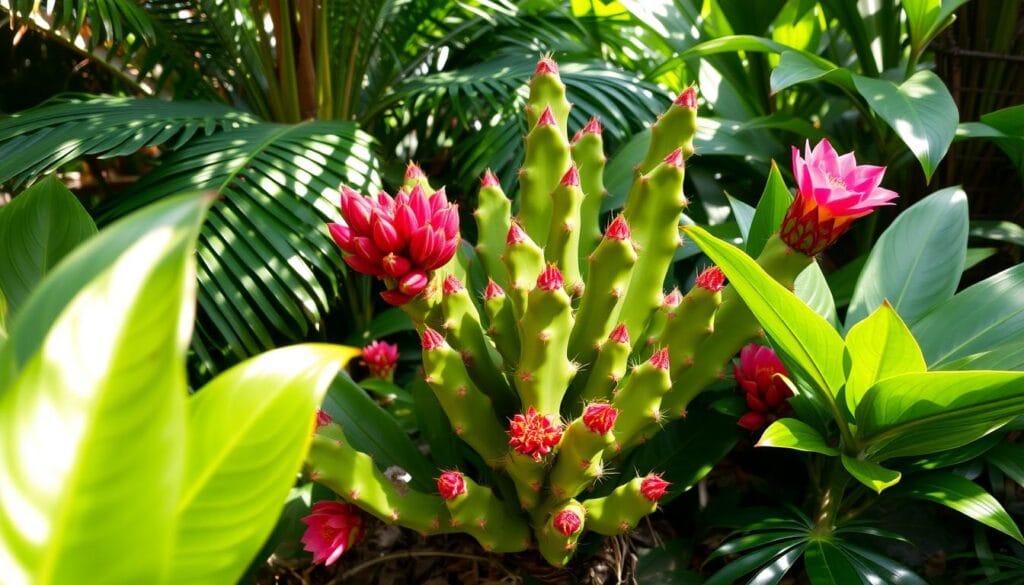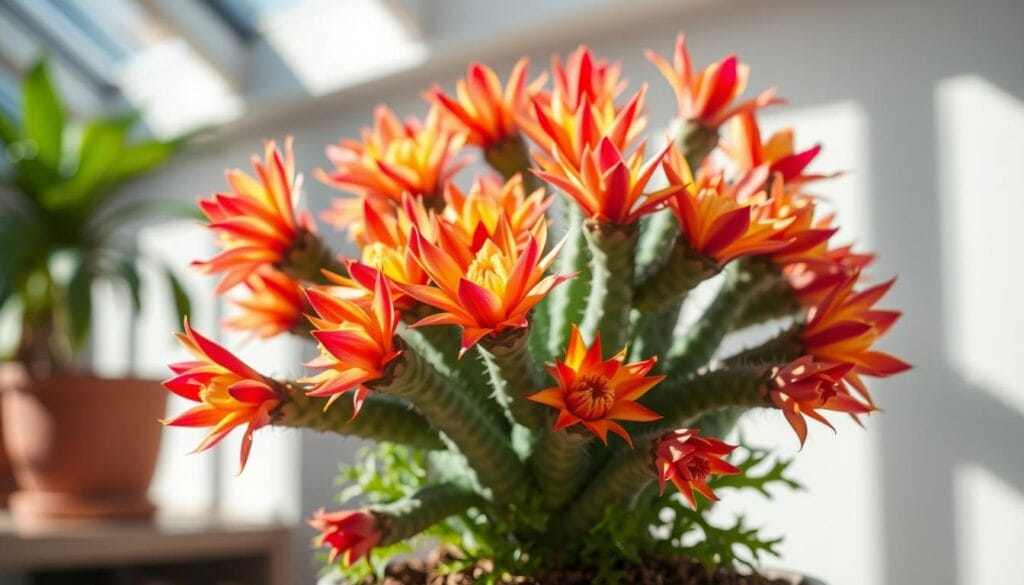Did you know over 200 types of Christmas cactus exist? They come in a wide range of flower colors1. This shows how popular and diverse this holiday plant is. As someone who loves succulents, I’m happy to share what I know about Christmas cactus care with you.
The Christmas cactus comes from the Brazilian rainforests. It’s different from desert plants1. It has colorful, tube-shaped flowers that bloom around Thanksgiving or Christmas12. With the right care, you can see these flowers every year.
In this guide, we’ll cover the basics of Christmas cactus care. We’ll talk about light, water, temperature, and how to grow more plants. Whether you’re new to plants or have experience, you’ll find helpful tips to keep your Christmas cactus happy.
Key Takeaways
- Christmas cacti prefer bright, indirect light and moderate humidity
- Proper watering and well-draining soil are crucial for healthy growth
- Temperature manipulation can encourage blooming during the holiday season
- Regular pruning promotes bushier growth and more flowers
- Christmas cacti are easily propagated through stem cuttings
- Fertilization and repotting schedules are important for long-term care
- Monitoring for pests and diseases is essential for plant health
Introduction to Christmas Cactus (Schlumbergera spp.)
I’m excited to introduce you to the fascinating world of Christmas cacti. These flowering cacti are a unique group of tropical cactus species. They bring joy to many homes during the holiday season.
Origin and Natural Habitat
Christmas cacti come from the lush coastal mountains of southeastern Brazil. Unlike desert cacti, they thrive in humid rainforest conditions. They grow as epiphytes, clinging to tree branches in their native habitat34.

Types of Holiday Cacti
The term “Christmas cactus” often refers to several related species. The most common are:
- Thanksgiving cactus (Schlumbergera truncata)
- Christmas cactus (Schlumbergera x buckleyi)
- Easter cactus (Schlumbergera gaertneri)
Interestingly, the Thanksgiving cactus is often mislabeled as a Christmas cactus in stores5.
Unique Characteristics and Appeal
What makes these cacti so special? Their stunning flowers! These plants produce vibrant blooms in shades of white, pink, yellow, orange, red, or purple. The crab cactus, another name for the Thanksgiving cactus, gets its moniker from its distinctive claw-like stem segments3.
Christmas cacti can live for decades with proper care. They bloom in response to shorter days and cooler temperatures, making them perfect holiday plants. Their ability to thrive in humid conditions sets them apart from typical desert cacti, adding to their unique appeal435.
Light Requirements for Optimal Growth
I love how Christmas cacti thrive in bright indirect light. They’re perfect for an east-facing window. These plants need about 6-8 hours of indirect sunlight daily for the best growth6. Placing them near a north or east-facing window works wonders, shielding them from harsh midday sun that can cause leaf burn7.
During the flowering season, Christmas cacti need specific light conditions. They require about 13 hours of continuous darkness each day to trigger flowering7. To encourage blooming, I aim for 14 hours of darkness daily for about six weeks8. This light manipulation, combined with cooler temperatures between 55°F and 65°F, sets the stage for a spectacular holiday display78.

If natural light is limited, especially during darker months, I turn to grow lights. LED lights are my go-to choice as they’re energy-efficient and provide a full spectrum of light beneficial for Christmas cacti7. I position the grow lights 12-24 inches away from the plant and expose it for 12-14 hours daily6. This setup mimics natural light cycles and promotes healthy growth and flowering.
| Light Condition | Duration | Purpose |
|---|---|---|
| Bright Indirect Light | 6-8 hours daily | Optimal growth |
| Darkness | 13-14 hours daily | Trigger flowering |
| Grow Lights | 12-14 hours daily | Supplement natural light |
Remember, consistent light exposure is key for vibrant blooms6. I regularly rotate my Christmas cactus to ensure even growth and flowering7. By paying attention to these light requirements, you’ll be rewarded with a healthy, flourishing succulent houseplant that brings joy during the holiday season.
Watering Techniques for Christmas Cactus
Proper watering is key for your Christmas cactus’s health. I’ll share tips to keep your plant thriving with the right watering method.
Frequency and Amount
In spring and summer, water your Christmas cactus every two to three weeks9. I check the soil moisture by feeling about an inch below the surface. If it’s dry, it’s time to water10. This frequency keeps the soil moist without overwatering.
Avoiding Overwatering
Overwatering can cause root rot. I watch for signs like limp, discolored leaves, which show stress or root problems9. To avoid this, I use a well-draining pot and adjust my watering based on humidity and light levels9.
Seasonal Adjustments
In fall and winter, I water less as the plant goes dormant. I let the top inch of soil dry out completely between waterings9. This helps prevent root rot in cooler months when the plant needs less water.
Remember, Christmas cacti do best in temperatures between 60-75°F and bright, indirect light10. These factors impact their water needs, so I adjust my watering schedule accordingly.
Temperature and Humidity Preferences
The Christmas Cactus loves warm temperatures but not too hot. It grows best when it’s around 70°F during the day and 60°F at night11. This keeps it healthy and encourages it to bloom.
When it’s growing and blooming, it likes it even cooler. It prefers temperatures between 65–69°F12. To make it bloom, it needs two cool periods a year. These should be between 55–59°F from mid-September to when buds appear and after it blooms until late March12.
Humidity is also important for Christmas Cacti. They do best in humid air, between 50-60%11. To keep the air right, you can:
- Use pebble trays
- Mist the plant regularly
- Group plants together
- Employ a humidifier
These methods help a lot, especially when it’s dry or in low-humidity homes. A hygrometer can help you keep an eye on the humidity11.
Humidity needs change with the seasons. In spring and summer, it needs more water. But in fall and winter, it needs less1112. Keeping the right humidity and temperature is crucial for your Christmas Cactus to grow well and bloom beautifully.
Soil and Potting Requirements
Christmas cacti need the right soil to grow well. I’ll show you the best soil mix, pot choices, and when to repot. This will help your cactus bloom beautifully.
Ideal Soil Composition
Christmas cacti love soil that drains well and is rich in organic matter. A succulent potting mix is perfect. Mix 1 part sterilized soil, 1 part compost, and 1 part sand or fine gravel13. This combo ensures good aeration and drainage.
For a soilless mix, use 1 part cactus mix, 1 part orchid mix, and 1 part horticultural pumice or sand13. The soil’s pH should be slightly acidic, between 5.7 and 6.513.
Choosing the Right Pot
Choose a pot with drainage holes to avoid waterlogged soil. Christmas cacti do best when slightly pot-bound, which encourages blooming. Make sure the pot allows for airflow and water drainage14.
Repotting Guidelines
Repot your Christmas cactus every three to four years, or when it grows too big for its pot14. Wait until after it blooms to repot, so it can adjust to its new home14. When you do repot, place the roots at least an inch from the pot’s bottom14.
| Soil Component | Purpose |
|---|---|
| Peat or Compost | Organic matter for nutrients |
| Perlite or Pumice | Improves drainage and aeration |
| Sand or Fine Gravel | Enhances drainage |
| Vermiculite | Retains moisture and nutrients |
Christmas cacti come from rainforests, so they need soil that holds moisture but also drains well13. With the right soil and pot, your Christmas cactus will bloom beautifully every year.
Fertilizing Your Christmas Cactus
I love taking care of my Christmas cactus to make sure it blooms beautifully. A key part of caring for it is to follow a good feeding schedule. From late winter to late summer, I fertilize it every month. This helps it grow well and get ready to bloom15.
To get the best results, I use a balanced fertilizer with a 20-20-20 or 20-10-20 mix. These mixes have more phosphorus, which helps the plant grow strong and bloom well15. In spring and summer, I use it every other week. In fall and winter, I cut back to once a month15.
To meet my plant’s magnesium needs, I add Epsom salts every two weeks. I use one teaspoon for every gallon of water15. This, along with balanced fertilizer, makes sure my Christmas cactus gets all the nutrients it needs for healthy growth and blooming.
I’m careful not to over-fertilize, as it can harm the plant. To avoid this, I dilute the fertilizer more than recommended and watch for drainage. If I see signs of over-fertilizing, like yellow leaves or browning tips, I flush the soil with water to get rid of extra nutrients15.
For those who like a low-maintenance option, slow-release fertilizers are great. You can apply them once a year in spring. They slowly release nutrients over time15.
| Fertilizer Type | Application Frequency | Benefits |
|---|---|---|
| Balanced Liquid (20-20-20) | Bi-weekly (Spring/Summer) | Promotes overall growth |
| Epsom Salts | Bi-weekly | Fulfills magnesium needs |
| Slow-Release Pellets | Once yearly (Spring) | Low-maintenance option |
By following these fertilizing tips, I keep my Christmas cactus healthy and it blooms beautifully every year.
Pruning and Shaping Techniques
Pruning is key to keeping your Christmas cactus healthy and vibrant. I’ll show you the best ways to shape your plant and encourage growth.
When to Prune
The best time to prune your Christmas cactus is from January to February16. This helps it grow well and bloom more16. You’ll know it’s time to prune if it’s too long, leaves are yellow, or it’s not blooming much16.
How to Prune for Bushier Growth
To make your cactus bushier, use two pruning methods: cutting for big changes and pinching for small ones16. Cut just above a joint to make new growth and get rid of dead parts16. You can cut up to one-third of the plant each year17.
Using Pruned Segments for Propagation
Don’t throw away stem cuttings! You can use them to grow new plants17. This method also helps your plant bloom more. After pruning, let the soil dry a bit before watering again and keep it out of direct sunlight16.
After pruning, make sure to care for your plant well. Water it well and watch for new growth17. Use a balanced fertilizer (10-10-10) lightly every month to help your cactus grow strong17.
Propagation Methods for Christmas Cactus
I love propagating Christmas cacti! It’s a fun way to create new plants and share the joy with friends. The best time to start is after the blooming cycle in late winter or early spring18.
To begin, I select healthy stem cuttings with 2-3 jointed segments. This increases the chances of successful rooting18. I let the cuttings dry for a few hours before planting them in well-draining soil rich in organic matter19.
After planting, I keep the soil moist but not waterlogged. Overwatering can lead to root rot, so I’m careful with moisture levels18. I place the cuttings in bright, indirect light as direct sunlight can scorch them18.
The rooting process takes patience. It typically takes 6 to 8 weeks for roots to develop20. During this time, I maintain a temperature between 65-75°F, which is ideal for rooting18.
Once roots form, I treat the new plants like mature Christmas cacti. I water sparingly, about 1 inch per week during the growing season20. For fertilizing, I use a water-soluble, high-phosphorus fertilizer every two to four weeks19.
Propagating Christmas cacti is rewarding and creates personalized gifts. It’s a great way to expand my plant collection and share the beauty of these unique plants with others18.
Encouraging Blooming in Christmas Cactus
Christmas cacti are stunning holiday plants with vibrant flowers in many colors. They come from South American rainforests. These plants are loved for their long-lasting blooms in red, rose, purple, lavender, orange, and white21.
Light and Temperature Manipulation
To get your Christmas cactus to bloom, controlling light and temperature is key. They need 12-14 hours of darkness each day to bloom during the holidays22. One way to do this is by putting the plant in a dark closet for 14 hours each night, starting 6-8 weeks before you want it to bloom21.
Temperature is also important. Keep the plant’s nighttime temperature between 45-55°F in a well-ventilated room. You can do this by sleeping with windows open or using a fan21. During the day, aim for 60-70°F22.
Timing for Holiday Blooms
To bloom for the holidays, start adjusting light and temperature in late September or early October. Keep going until flower buds appear, then keep it a bit warmer for full bloom21. Remember, Christmas cacti can bloom at unexpected times.
Troubleshooting Bloom Issues
If your cactus isn’t blooming, check its environment. Make sure it gets bright, indirect light during the day. Keep humidity levels between 40% to 50% during growth and blooming22. Also, fertilize regularly with a high-phosphorus fertilizer every 2-4 weeks during the growing season to help it flower22.
| Factor | Optimal Condition |
|---|---|
| Light | 12-14 hours of darkness daily |
| Temperature | 45-55°F at night, 60-70°F during day |
| Humidity | 40-50% |
| Fertilization | High-phosphorus, every 2-4 weeks |
Common Pests and Diseases
Christmas cacti are generally tough, but they can still face some challenges. Pests like aphids, red spider mites, and mealybugs can be a problem. These pests can stress your plant and slow its growth. To keep pests away, I regularly check my cactus and gently wipe its leaves with a damp cloth.
Diseases can also be a big issue. Root rot often happens when you water too much. If your cactus wilts and has black spots, it might be getting too much water23. To avoid this, I let the soil dry out between waterings. Botrytis blight, a fungal disease, can also be a problem. If you see greyish mold, it’s best to isolate and destroy the plant to prevent it from spreading23.
To keep your Christmas cactus healthy, prevention is key. I make sure it gets the right amount of light (about 1500 to 3000 foot-candles) and keeps the soil temperature between 70 to 80°F24. If problems do occur, it’s important to act fast. Brown spots on the stem could mean stem rot from too much water, which is serious23. In bad cases, you might need to use fungicides for diseases like Fusarium basal stem rot or Pythium root rot25. A healthy cactus is a strong cactus!
FAQ
What is the natural habitat of Christmas Cactus?
What are the different types of holiday cacti?
What light conditions are best for growing Christmas Cactus?
How often should I water my Christmas Cactus?
What are the temperature and humidity preferences for Christmas Cactus?
What type of soil and pot is best for Christmas Cactus?
How do I fertilize my Christmas Cactus?
When and how should I prune my Christmas Cactus?
How can I propagate Christmas Cactus?
How do I encourage blooming in my Christmas Cactus?
What are some common pests and diseases that affect Christmas Cactus?
Source Links
- Schlumbergera truncata (Christmas Cactus, Common Winter Cactus, Crab Cactus, False Christmas Cactus, Lobster Cactus, Thanksgiving Cactus)
- How To Care For a Christmas Cactus, Thanksgiving Cactus, or Easter Cactus
- Schlumbergera
- Cafe Planta
- Commercial Producton of Holiday Cacti
- 🎄 Best Light Conditions for True Christmas Cactus
- 🌞 How Much Sunlight Does My Christmas Cactus Need?
- Christmas Cacti Care and Propagation – Bootstrap Farmer
- Flora | Mastering Moisture: Christmas Cactus Watering Tips
- How to Care For a Christmas Cactus | Petitti Garden Centers
- 🎄 How Much Humidity Does My Christmas Cactus Need?
- How to grow Christmas cactus / RHS Gardening
- Best Potting Mix for a Christmas Cactus | Gardener’s Path
- What Soil is Best for a Christmas Cactus?
- How to Fertilize Your Christmas Cactus
- 🎄 Step-by-Step Guide to Trimming True Christmas Cactus
- How Should Christmas Cactus Be Cut Back?
- Flora | Step-by-Step: How to Propagate Christmas Cactus
- Christmas Cactus
- Make More of Your Favorite Christmas Cactus from Cuttings with These Simple Steps
- How to encourage your Christmas cactus to bloom for the holidays
- Christmas Cactus
- Common Christmas Cactus Problems And The Solutions
- Holiday Cactus Production Guide
- Christmas Cactus Diseases


